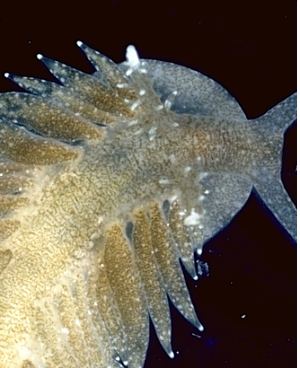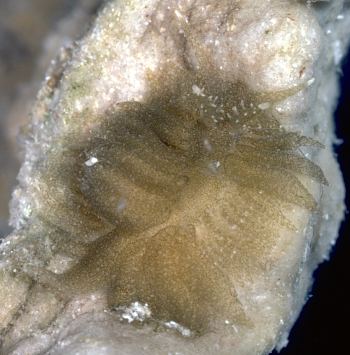
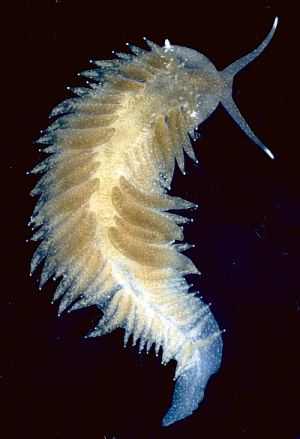
Aeolidiopsis harrietae
Rudman, 1982
Order: NUDIBRANCHIA
Suborder: AEOLIDINA
Family: Aeolidiidae
DISTRIBUTION
Known at present from the southwestern Pacific [Great Barrier Reef, New Caledonia].
PHOTO
40mm long, Heron Is, Cent Qld, on Palythoa sp. June, 1983. AM C138598. Photos: Bill Rudman
The animal broad and elongate, with a wide foot, rounded at the anterior end. It can grow to 40mm in length. The oral tentacles are relatively small with bluntly rounded tips. The rhinophores are short and rounded, and bear a few long papillae. The cerata are dorsoventrally flattened, broadly rounded along the anterior edge and with an angle about midway along the posterior edge. They are relatively large and lie out from the body, either held horizontally, or sometimes following the contour of the side of the body before extending out horizontally. The cerata are arranged in almost horizontal rows with a slight anterior downwards slope. They are arranged so that only the anterior edge of each ceras is shaded by the ceras in front. There is only one ceratal row anterior to the pericardium.
The whole animal appears a brownish straw colour from internal body fluids. All the dorsum has a network of fine red-brown specks, rather irregularly arranged on the head, but forming a transverse pattern on the dorsum behind the rhinophores. The dorsal side of the oral tentacles has similar markings and so do the rhinophores, except for the tip and the ends of the papillae, which are yellowish white. The anterior end of the foot and the posterior end of the foot also have this brown network. The part of the foot that lies beneath the cerata is straw coloured with white specks. The sides of the body beneath the cerata are straw coloured with only a very few patches of brown. The dorsal surface of the cerata is covered with a brown reticulate pattern but the edges and the ventral surface are not. There is a white tip to each ceras and white patches on the upper third of the dorsal side. There is also a distinctive white knob halfway along the posterior edge of each ceras. The sole of the foot is straw coloured.
The digestive gland branches in all the cerata, and as well as small tubules on the dorsal body wall there are many large tubules in the dorsal body cavity. The cells of the digestive gland contain many zooxanthellae, especially near the dorsal surface of the body and the posterior edge and upper third of each ceras. It is the zooxnathellae that give the animal its brown colouration. The cnidosac is relatively large.
When crawling on the colonial zoantharian Palythoa, the animal is extremely difficult to see. As with Aeolidiopsis ransoni, the cerata are held either horizontally or lower, sometimes following the contour of the side of the body then lying out horizontally just above the foot. The morphological peculiarities, such as reduced number of flattened cerata arranged in almost horizontal rows and complex ramifications of the digestive gland throughout the body wall, suggest a symbiotic relationship with zooxanthellae obtained from Palythoa. Aeolidiopsis harrietae can be distinguished from A. ransoni by its papillate rhinophores, position of the anus below the ceratal rows, and shape of the radular teeth.
See:
• A. ransoni - Biology and natural history.
• A. ransoni.
• Solar-powered Opisthobranchs
• Feeding on Palythoa
Reference:
• Rudman, W.B. (1982) The taxonomy and biology of further aeolidacean and arminacean nudibranch molluscs with symbiotic zooxanthellae. Zoological Journal of the Linnean Society, 74: 147-196.
Rudman, W.B., 2002 (July 18) Aeolidiopsis harrietae Rudman, 1982. [In] Sea Slug Forum. Australian Museum, Sydney. Available from http://www.seaslugforum.net/find/aeolharr
Related messages
Re: Aeolidiopsis harrietae sp. from Kasheli, Ratnagiri
November 17, 2009
From: Vishal Bhave
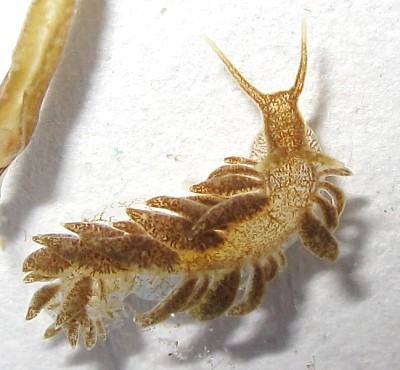
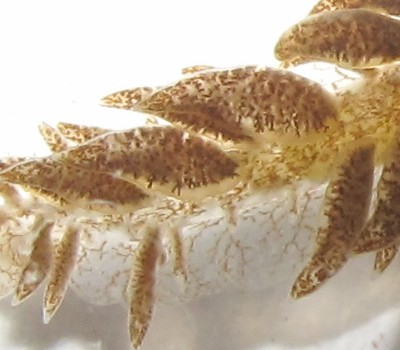
Dear Bill
I don't have images of it in its habitat as it was collected by my friend Rahul Athaley.
Locality: Kasheli, Rajapur, Ratnagiri, 16 cm, Maharashtra, India, Arabian sea, 31 October 2009, Intertidal, beneath the rock, in rockpool. Length: 08 mm. Photographer: Vishal Bhave.
Vishal Bhave
vishalbhave@gmail.com
Bhave, V.J., 2009 (Nov 17) Re: Aeolidiopsis harrietae sp. from Kasheli, Ratnagiri. [Message in] Sea Slug Forum. Australian Museum, Sydney. Available from http://www.seaslugforum.net/find/22757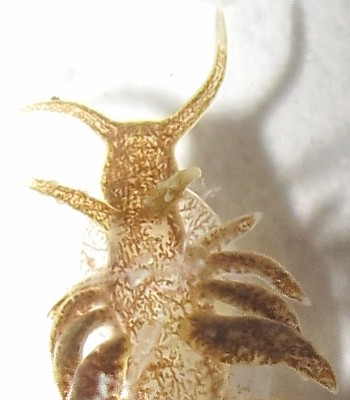
Dear Vishal,
This is an interesting species which lives on and feeds on the colonial sea anemone Palythoa. I am pretty sure your species is Aeolidiopsis harrietae. If you go to that Fact Sheet you will find links to further information on its interesting biology. It is one of those nudibranchs which takes zooxanthellae from its coelenterate prey and 'farms' them in its own body. The network of brown we can see in all parts of the body, are specialised ramifications of the digestive gland where the zooxanthellae are housed.
Terry Gosliner (1985) described a very similar animal from South Africa as Baeolidia palythoae. I have discussed elsewhere why I have decided to continue using Aeolidiopsis [see #7614]. At present, A. harrietae is known only from the SW Pacific which means that your animal from western India is much closer to the known localities of B. palythoae. However the only difference noted by Gosliner which I could possibly find from photos is a dark brown subapical ceratal gland which Gosliner said was present in all his specimens. I can see no sign of it in your photos so will take the conservative approach and identify it as A. harrietae. I think we need to find more populations of this/these species before we can say anything further.
Whatever species it eventually turns out to be, all these solar-powered nudibranchs are worthy of much more study.
- Gosliner, T. M. (1985). The aeolid nudibranch family Aeolidiidae (Gastropoda: Opisthobranchia) from tropical southern Africa. Annals of the South African Museum 95(6): 233-267.
Best wishes,
Bill Rudman
Aeolidiopsis harrietae from New Caledonia
July 24, 2002
From: Bill Rudman
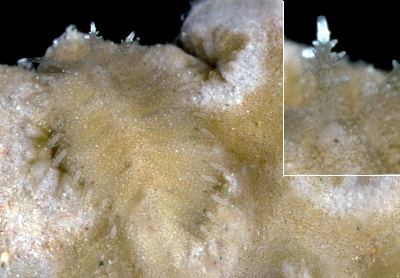
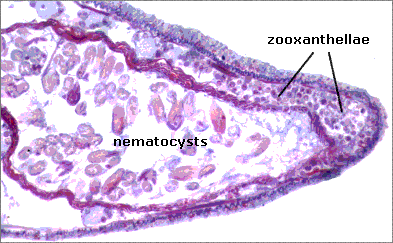
To accompany my photos of specimens from the Great Barrier Reef, here are some photos of Aeolidiopsis harrietae from the south coast of New Caledonia. This species lives and feeds on colonies of the colonial sea-anemone Palythoa living on the reef crest. I almost missed finding these animals as I was so enjoying the hospitality of my French host - and his wine, sitting under a tree on the beach, that we completely missed the low tide.
Touaourou, S of Yate, E Coast, New Caledonia, 25 October 1988, on Palythoa at crest of fringing reef, 35-40mm long. AM C156692. Photos: Bill Rudman
The middle photo shows a section through the ceratal tip showing the cnidosac packed full of the large nematocysts found in the connecting tissue of the Palythoa colony, between the polyps. Above the cnidosac, zooxanthellae can be seen packed near the dorsal surface.
Best wishes,
Bill Rudman
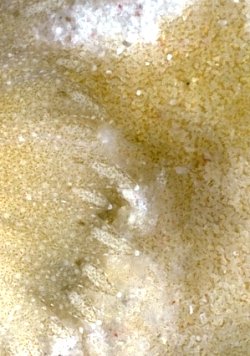
This photo is a closeup of a section of the animal (left side) on the Palythoa colony showing how well it is camouflaged. The whitish objects, pointed at both ends, are the cnidosacs at the tips of each ceras.
Is Aeolidiopsis a good genus?
July 24, 2002
From: Bill Rudman
To accompany the pages I have just posted on Aeolidiopsis ransoni and Aeolidiopsis harrietae it is necessary to discuss what genus these species should be placed in, particularly since Terry Gosliner, described a third species from South Africa, which he placed in the genus Baeolidia, (B. palythoae).
Placing these species in a genus is somewhat problematic. The radula and jaw plates undoubtedly place them in the Aeolidiidae. Pruvot-Fol erected the genus Aeolidiopsis for A. ransoni, citing the general body form, the single row of cerata, the dorsal position of the anus, and absence of cnidosacs, as features distinguishing it from other genera of the Aeolidiidae. Of these characters, the body form as described by her with the foot folded up the sides of the body, was an artefact of preservation, and the absence of cnidosacs, was an error on her part. Despite this, the position of the anus and the way the cerata are arranged, suggest that this genus is justified.
However are the other two Palythoa feeders closely related to A. ransoni or are their similarities a result of their same lifestyle? Neither A. harrietae nor A. palythoae have a dorsal anus, and unlike A. ransoni they both have papillate rhinophores. It is difficult to determine which morphological characters possessed by these Palythoa feeders are related to their development of symbiosis with zooxanthellae, and which characters can be considered of phylogenetic importance. For instance, the relatively small number of cerata arranged in a few sloping rows is unusual in the family. The similarity may suggest close phylogenetic affinity, but it could also suggest convergence of two unrelated species which have evolved similar symbiosis. The papillate rhinophores in A. harrietae are reminiscent of 'Berghia' and the ceratal arrangement could be derived from the Berghia-Spurilla group by the loss of the posterior limbs of the anterior arches. The radula is also similar to that of Berghia.
All three species differ from most genera in having a simple rounded anterior end to the foot, and their jaw plates differ from other genera in having a great elaboration of the anterior flange. This may be functionally related to their tough food, so again it is difficult to know whether this common structure is functional convergence or phylogenetic. Miller (2001), in his recent review of the family considers Aeolidiopsis to be a valid genus for A. ransoni but considers the other two species, rather than being placed in Baeolidia, as proposed by Gosliner (1985), should be placed in a new genus. I think we have to remember the lesson presented to us by the soft-coral feeding genus Phyllodesmium when comparing anatomical similarities and differences. Within the genus we can find most of the external anatomical features which are used elsewhere in the Aeolidioidea to delineate families and genera. In fact until relatively recently most species, of what we now place in the genus Phyllodesmium, were placed in their own monotypic genera, often in monotypic families (Rudman, 1981, 1982). I might be shown to be quite wrong, but I feel that all three Palythoa - feeders are closely related, and so feel it is most appropriate to leave them all the in the genus Aeolidiopsis.
References:
• Gosliner, T.M. (1985) The aeolid nudibranch family Aeolidiidae (Gastropoda: Opisthobranchia) from tropical southern Africa. Annals of the South African Museum, 95(6): 233-267.
• Miller, M.C. (2001) Aeolid nudibranchs (gastropoda: Opisthobranchia) of the family Aeolidiidae from New Zealand waters. Journal of Natural History, 35: 629-662.
• Rudman, W.B. (1981) The anatomy and biology of alcyonarian feeding aeolid opisthobranch molluscs and their development of symbiosis with zooxanthellae. Zoological Journal of the Linnean Society 72: 219-262.
• Rudman, W.B. (1982) The taxonomy and biology of further aeolidacean and arminacean nudibranch molluscs with symbiotic zooxanthellae. Zoological Journal of the Linnean Society, 74: 147-196.
• Rudman, W.B. (1991) Further studies on the taxonomy and biology of the octocoral-feeding genus Phyllodesmium Ehrenberg, 1831 (Nudibranchia: Aeolidoidea). Journal of Molluscan Studies, 57(2): 167-203.
Best wishes,
Bill Rudman
Aeolidiopsis harrietae from GBR
July 24, 2002
From: Bill Rudman

Hare are some photos of Aeolidiopsis harrietae from Heron Island, at the southern end of the Great Barrier Reef. It was found, with A. ransoni in beds of Palythoa on the reef flat. two species of Palythoa were commonly present, one very green, and the other brownish yellow with brown speckling. Both species of Aeolidiopsis were only ever found with the brownish yellow species.
• 40mm long, Heron Is, Great barrier reef, on Palythoa sp. June, 1983 AM C138598. Photos: Bill Rudman
This species was usually found at the edge of a
Best wishes,
Bill Rudman
